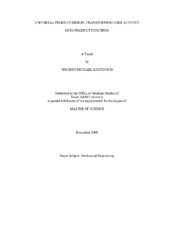| dc.contributor.advisor | McAdams, Daniel A. | |
| dc.creator | Kostovich, Vincent | |
| dc.date.accessioned | 2010-07-15T00:15:20Z | |
| dc.date.accessioned | 2010-07-23T21:46:12Z | |
| dc.date.available | 2010-07-15T00:15:20Z | |
| dc.date.available | 2010-07-23T21:46:12Z | |
| dc.date.created | 2009-12 | |
| dc.date.issued | 2010-07-14 | |
| dc.date.submitted | December 2009 | |
| dc.identifier.uri | https://hdl.handle.net/1969.1/ETD-TAMU-2009-12-7398 | |
| dc.description.abstract | Many people have disabilities and would like to have all of the amenities typical
of daily life. Universal product design is important in designing for the disabled and
creating user-friendly products for all people. The goal of this thesis is to develop a
universal product method by understanding how user activity closely resembles product
function.
The research results include a twenty product pair study in which a universal and
typical product were compared. An activity diagram and functional model for each
product in the product pair were the design tools used for this comparison. User activities
were used to cluster product function changes. In addition, design changes such as
functional, morphological and parametric were identified between the universal and
typical product. The result was an action-function diagram showing the clusters and
design changes for all of the twenty product pairs.
An interactive GUI universal product design repository detailing the information
from the action-function diagrams was created and used for eventual modification of
typical products to make them universal. A universal product family was created using a
user-centric universal design method developed because of the universal product design repository. Furthermore, user disability ratings from the ICF helped to expand the
database and make creation of a universal product family more focused on levels of
disability.
The useful application of the research will be in developing a universal design
method for product designers and engineers. This method will be broken down into a
design structure matrix representation of functions from a universal product family of
household kitchen appliances. In addition, an embodied concept for a product family
consisting of existing accessible dispensers will be used to validate the universal design
method developed from the twenty product study. Both case studies will serve as an
example of how to extend universal design principles to a wide range of consumer
product categories. | en |
| dc.format.mimetype | application/pdf | |
| dc.language.iso | eng | |
| dc.subject | universal design | en |
| dc.subject | activity diagram | en |
| dc.subject | functional model | en |
| dc.subject | actionfunction diagram | en |
| dc.title | Universal Product Design: Transforming User Activity Into Product Function | en |
| dc.type | Book | en |
| dc.type | Thesis | en |
| thesis.degree.department | Mechanical Engineering | en |
| thesis.degree.discipline | Mechanical Engineering | en |
| thesis.degree.grantor | Texas A&M University | en |
| thesis.degree.name | Master of Science | en |
| thesis.degree.level | Masters | en |
| dc.contributor.committeeMember | Ochoa, Ozden O. | |
| dc.contributor.committeeMember | Stough, Laura S. | |
| dc.type.genre | Electronic Thesis | en |
| dc.type.material | text | en |


